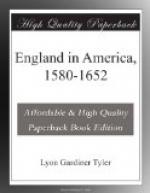November 7, 1629, Captain Mason obtained a patent[5] from the Council for New England for a tract extending sixty miles inland and lying between the Merrimac and Piscataqua rivers, being a part of the territory granted to Gorges and himself in 1622. He called it New Hampshire in honor of Hampshire, in England, where he had an estate. Seven days later the same grantors gave to a company of whom Mason and Gorges were the most prominent merchants, a patent for the province of Laconia, describing it as “bordering on the great lake or lakes or rivers called Iroquois, a nation of savage people inhabiting into the landward between the rivers Merrimac and Sagadahoc, lying near about forty-four or forty-five degrees.” And in 1631 Gorges, Mason, and others obtained another grant for twenty thousand acres, which included the settlement at the mouth of the Piscataqua.
Under these grants Gorges and Mason spent upward of L3000[6] in making discoveries and establishing factories for salting fish and fur trading; but as very little attention was paid to husbandry at either of the settlements on the Piscataqua, they dragged out for years a feeble and precarious existence. At Piscataqua, Walter Neal was governor from 1630 to 1633 and Francis Williams from 1634 to 1642, and the people were distinctly favorable to the Anglican church. At Cocheco, Captain Thomas Wiggin was governor in 1631; and when, in 1633, the British merchants sold their share in the plantation to Lord Say and Sele, Lord Brooke, and two other partners, Wiggin remained governor, and the transfer was followed by the influx of Puritan settlers.[7]
After the Antinomian persecution in Massachusetts some of Mrs. Hutchinson’s followers took refuge at Cocheco, and prominent among them were Captain John Underhill and Rev. John Wheelwright. Underhill became governor of the town in 1638, and his year of rule is noted for dissensions occasioned by the ambitious actions of several contentious, immoral ministers. Underhill was the central figure in the disturbances, but at the next election, in 1639, he was defeated and Roberts was elected governor of Cocheco. Dissensions continued, however, till in 1640 Francis Williams, governor of Piscataqua, interfered with an armed force. Underhill returned to Boston, and by humbly professing repentance for his conduct he was again received into the church there.[8] He then joined the Dutch, but when Connecticut and New Haven were clamorous for war with the Dutch in 1653 he plotted against his new master, was imprisoned, and escaped to Rhode Island,[9] where he received a commission to prey on Dutch commerce.
Meanwhile, Mr. Wheelwright left Cocheco, and in 1638 established southeast of it, at Squamscott Falls, a small settlement which he and his fellow-colonists called Exeter.[10] In October, 1639, after the manner of the Rhode Island towns, the inhabitants, thirty-five in number, entered a civil contract to “submit themselves to such godly and Christian lawes as are established in the realm of England to our best knowledge, and to all other such lawes which shall, upon good ground, be made and enacted among us according to God.” This action was followed in 1641 by their neighbors at Cocheco, where the contract was subscribed by forty-one settlers; and about the same time, it is supposed, Piscataqua adopted the same system.[11]




